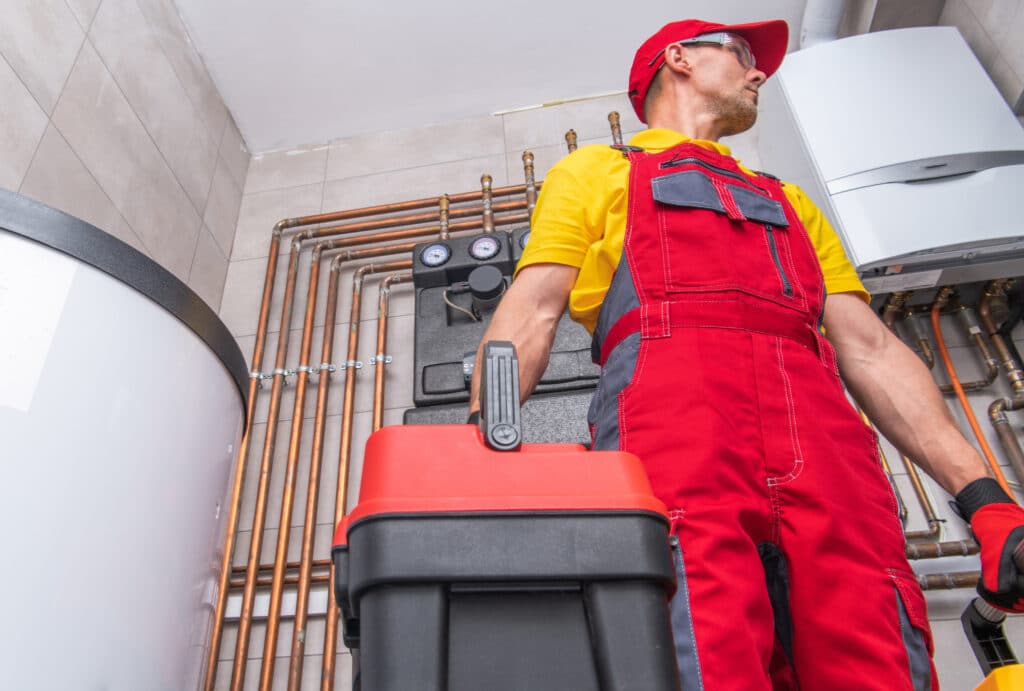Top 5 Benefits of Tankless Water Heaters

Are you tired of running out of hot water during your morning shower?
Tankless water heaters could be the solution you need. Unlike traditional tank-style water heaters, which store a finite amount of hot water, tankless water heaters provide hot water on demand. This means you can enjoy a continuous supply of hot water whenever you need it, without the limitations of a storage tank.
Tankless water heaters, also known as on-demand water heaters, operate by heating water directly as it flows through the unit. When you turn on a hot water tap, cold water travels through a pipe into the unit where either a gas burner or an electric element heats the water instantly. This eliminates the need for a storage tank, making tankless water heaters more energy-efficient and space-saving.
How They Differ from Traditional Tank-Style Heaters
Traditional tank-style water heaters keep a reservoir of hot water ready for use. This method can lead to significant energy waste, as the heater constantly works to maintain the water’s temperature. In contrast, tankless water heaters only activate when hot water is needed, which can result in substantial energy savings.
Additionally, tank-style heaters are bulky and require ample space for installation. They can also run out of hot water if the demand exceeds the tank’s capacity. On the other hand, tankless water heaters are compact and can be installed in smaller spaces, such as closets or even mounted on walls, offering greater flexibility.
Choosing a tankless water heater means investing in a modern, efficient, and reliable hot water solution that adapts to your household’s needs. With the advantages of energy efficiency, space-saving design, and an endless supply of hot water, tankless water heaters are becoming a popular choice for homeowners looking to upgrade their home’s water heating system.
Benefit 1: Energy Efficiency
Have you ever wondered how much energy your water heater uses?
Tankless water heaters are known for their energy efficiency, making them a smart choice for homeowners. Unlike traditional tank-style heaters that constantly heat a large tank of water, tankless heaters only heat water as you need it. This on-demand heating process can lead to significant energy savings.
Explanation of Energy Savings
Tankless water heaters can be up to 34% more energy-efficient than traditional tank-style heaters for homes that use 41 gallons or less of hot water daily. For homes using around 86 gallons per day, they can be 14% more efficient. This efficiency stems from the elimination of standby heat loss, which is the energy wasted by keeping water hot in a tank.
Comparison with Tank-Style Heaters
Traditional water heaters maintain a reservoir of hot water, which results in energy loss as the water cools down and needs reheating. In contrast, tankless heaters activate only when you need hot water. This means you’re not paying to keep water hot 24/7, translating to lower energy bills.
Environmental Impact
Reducing energy consumption not only saves you money but also benefits the environment. Lower energy use means fewer carbon emissions, helping to reduce your household’s carbon footprint. By switching to a tankless water heater, you’re making a greener choice that contributes to environmental sustainability.
Tankless water heaters offer a more efficient way to meet your hot water needs. Their ability to heat water on demand, combined with reduced energy consumption, makes them an attractive option for eco-conscious homeowners. With significant energy savings and a positive impact on the environment, tankless water heaters stand out as a smart investment for both your wallet and the planet.
Benefit 2: Space-Saving Design
Do you have limited space in your home? Tankless water heaters are designed with compactness in mind, offering a significant space-saving advantage over traditional tank-style heaters. Their sleek, wall-mounted design can free up valuable floor space in your home.
Physical Size Comparison
Traditional tank-style water heaters can be bulky, often requiring a large footprint in your utility room, basement, or garage. They typically measure around 60 inches tall and 24 inches in diameter, taking up considerable space. In contrast, tankless water heaters are much smaller, usually about the size of a carry-on suitcase, and can be mounted on walls. This makes them an excellent option for homes with limited space.
Installation Flexibility
One of the standout features of tankless water heaters is their installation flexibility. They can be installed in various locations, such as closets, under sinks, or even outside the house. This flexibility allows homeowners to choose the most convenient and efficient spot for their heater, optimizing space usage. Additionally, their lightweight design makes them easier to install, which can reduce installation costs.
Ideal Locations for Installation
Ideal locations for installing a tankless water heater include utility closets, garages, basements, or even outdoors in a weatherproof enclosure. For homes with limited indoor space, placing the unit outside can be a practical solution. This not only saves indoor space but also keeps the unit out of sight.
Tankless water heaters’ compact size and flexible installation options make them a smart choice for modern homes. By choosing a tankless water heater, you can free up space in your home and enjoy the convenience of placing the unit in the most suitable location. This benefit is especially valuable for smaller homes or apartments where every square foot counts.
Benefit 3: Endless Supply of Hot Water
Ever run out of hot water halfway through your shower? With a tankless water heater, that problem becomes a thing of the past. One of the most compelling benefits of tankless water heaters is their ability to provide an endless supply of hot water, ensuring you never experience a cold shower again.
How On-Demand Heating Works
Tankless water heaters heat water directly without the need for a storage tank. When you turn on a hot water tap, cold water flows through the unit, where either a gas burner or an electric element heats it instantly. This process ensures a continuous flow of hot water, as long as there is water flow and the heater’s capacity isn’t exceeded.
Performance During Peak Usage
Tankless water heaters shine during peak usage times, such as mornings when multiple family members are showering, the dishwasher is running, and the washing machine is on. Unlike traditional heaters that can deplete their tank of hot water, tankless systems provide hot water on demand, maintaining performance even during high usage periods.
Tankless water heaters also excel in scenarios like filling a large bathtub. Traditional heaters may struggle to keep up with the demand for a continuous flow of hot water, but a tankless system ensures you have hot water until the tub is full.
The ability to provide endless hot water makes tankless water heaters a highly desirable choice for households with high hot water demands. By investing in a tankless water heater, you ensure that your home always has a reliable supply of hot water, regardless of the time of day or how many appliances are running.
Benefit 4: Longer Lifespan
Are you tired of replacing your water heater every 10 years? Tankless water heaters offer a longer lifespan compared to traditional tank-style heaters, making them a wise long-term investment for homeowners. With proper maintenance, a tankless water heater can serve you reliably for many years.
Average Lifespan of Tankless vs. Tank-Style Heaters
Traditional tank-style water heaters typically last about 10-15 years before they need to be replaced. In contrast, tankless water heaters can last up to 20 years or more. This extended lifespan is due to their advanced technology and fewer parts that are prone to wear and tear.
Factors Contributing to Longevity
Several factors contribute to the longevity of tankless water heaters. First, they experience less corrosion since they don’t store water, which reduces the risk of rust and mineral buildup. Second, their components are designed for durability and can be easily replaced, extending the overall life of the unit. Regular maintenance, such as descaling and cleaning, can further prolong the lifespan of your tankless water heater.
Cost Savings Over Time
Although tankless water heaters have a higher upfront cost, their extended lifespan can lead to significant cost savings over time. With a tankless system, you avoid the expense of frequent replacements and enjoy reduced energy bills due to their efficiency. Additionally, many manufacturers offer long-term warranties, providing added peace of mind.
For instance, if a traditional tank-style heater needs replacement every 12 years, over 24 years, you might buy two tank heaters. However, with a tankless heater that lasts 20 years or more, you only make one purchase within the same timeframe. This reduces your long-term costs and hassle.
The longer lifespan of tankless water heaters makes them a cost-effective and reliable choice for homeowners. By choosing a tankless system, you benefit from fewer replacements, lower maintenance costs, and extended performance. This makes tankless water heaters an excellent investment for ensuring a continuous supply of hot water for many years to come.
Benefit 5: Lower Risk of Leaks and Water Damage
Worried about water damage from a leaking heater? Tankless water heaters present a much lower risk of leaks and water damage compared to traditional tank-style heaters. Their design and operation reduce the common issues associated with tank-style systems.
How Tankless Systems Reduce Leak Risks
Traditional tank-style water heaters are prone to leaks because they constantly hold a large volume of water. Over time, corrosion and sediment buildup can cause the tank to crack or develop leaks, leading to water damage. Tankless water heaters, on the other hand, heat water on demand and do not store large amounts of water. This greatly reduces the risk of leaks and the potential for water damage in your home.
Maintenance Tips to Prevent Issues
While tankless water heaters have a lower risk of leaks, regular maintenance is essential to ensure they operate efficiently and last longer. Here are some maintenance tips to keep your tankless water heater in top condition:
- Descaling: Hard water can cause mineral buildup inside the unit, reducing efficiency. Describe your heater regularly to prevent this issue.
- Filter Cleaning: Clean the water inlet filter periodically to ensure proper water flow and prevent blockages.
- Professional Inspection: Schedule annual inspections by a professional to check for any potential issues and perform necessary maintenance.
- Ventilation Check: Ensure that the venting system is clear and functioning correctly to prevent exhaust buildup.
By choosing a tankless water heater, you can significantly reduce the risk of leaks and associated water damage. This peace of mind, combined with the other benefits of tankless systems, makes them an excellent choice for modern homes.
Considerations Before Installation
Thinking about installing a tankless water heater? Before making the switch, it’s important to understand the upfront costs, potential additional expenses, and necessary upgrades. Proper preparation ensures a smooth installation process and maximizes the benefits of your new system.
Upfront Costs and Potential Additional Expenses
Tankless water heaters generally have a higher upfront cost compared to traditional tank-style heaters. Potential additional expenses may include:
- Electrical Upgrades: If you choose an electric tankless water heater, you might need to upgrade your home’s electrical system to handle the increased load.
- Gas Line Installation: For gas models, you may need a new gas line or upgrades to your existing line to ensure proper fuel supply.
- Ventilation: Proper venting is crucial for gas tankless water heaters, which might require installing new vent pipes.
Necessary Upgrades (Electrical, Plumbing)
Installing a tankless water heater might necessitate specific upgrades to your home’s infrastructure. For electric models, you may need to install new circuit breakers and wiring to accommodate the higher electrical demand. Gas models might require enlarging the gas line to ensure adequate fuel flow.
Plumbing upgrades could include:
- Pipe Size Adjustments: Ensuring the pipes can handle the flow rate of the tankless heater.
- Water Softening System: In areas with hard water, installing a water softener can prevent mineral buildup in the heater.
Installation Process Overview
The installation process for a tankless water heater involves several steps to ensure proper setup and operation:
- Assessment: A professional plumber or technician will assess your home’s current water heating system, and electrical, and gas lines.
- Upgrades: Any necessary electrical, gas, or plumbing upgrades will be completed.
- Mounting: The tankless water heater unit will be mounted in the chosen location, such as a wall in the basement or utility closet.
- Connections: The unit will be connected to the water supply, electrical or gas lines, and venting system.
- Testing: The system will be tested to ensure it operates correctly and provides a continuous supply of hot water.

Photo from iStock – Credit: Olga Evtushkova
Types of Tankless Water Heaters
Understanding the types of tankless water heaters available can help you choose the best model for your home.
Electric vs. Gas Models
Tankless water heaters come in two main types: electric and gas.
- Electric Models: These heaters use electricity to heat the water. They are typically easier to install but may require significant electrical upgrades.
- Gas Models: These heaters use natural gas or propane to heat the water. They generally have higher flow rates and are more efficient in colder climates but require proper ventilation and gas line upgrades.
Pros and Cons of Each Type
- Electric: Easier to install, no need for ventilation, but may require electrical upgrades and higher operational costs.
- Gas: More efficient, especially in colder climates, and higher flow rates, but requires ventilation and potential gas line upgrades.
Best Applications for Each Type
- Electric: Ideal for smaller homes or apartments with lower hot water demand.
- Gas: Better suited for larger homes with higher hot water demand and in areas with cold winters.
Choosing the right type of tankless water heater depends on your home’s infrastructure, hot water needs, and budget. By understanding the considerations before installation, you can make an informed decision that ensures the best performance and efficiency from your tankless water heater.
FAQs
-
How long does a tankless water heater last?
Tankless water heaters typically last up to 20 years or more with proper maintenance. Their components are designed for durability, and many parts are replaceable, extending the unit’s lifespan compared to traditional tank-style heaters.
-
Are tankless water heaters worth the investment?
Yes, tankless water heaters are worth the investment. They offer significant energy savings, a longer lifespan, an endless hot water supply, and a lower risk of leaks. While the initial cost is higher, the long-term savings and benefits often outweigh the upfront expense.
-
What maintenance is required for a tankless water heater?
Regular maintenance for a tankless water heater includes descaling to prevent mineral buildup, cleaning the water inlet filter, and scheduling annual professional inspections. Proper maintenance ensures optimal performance and extends the heater’s lifespan.
-
Can tankless water heaters handle large households?
Yes, tankless water heaters can handle large households. It’s important to choose a unit with the appropriate flow rate (GPM) to meet your peak hot water demand. In some cases, installing multiple units can ensure a consistent supply of hot water for large homes.
-
What is the cost of installing a tankless water heater?
The cost of installing a tankless water heater varies, depending on the unit and installation. Factors such as electrical or gas line upgrades and venting requirements can affect the total installation cost. Despite the higher initial expense, the long-term energy savings and extended lifespan make it a cost-effective choice.



















